Related Research Articles

The House of Bourbon is a dynasty that originated in the Kingdom of France and is a branch of the Capetian dynasty, the royal House of France. Bourbon kings first ruled France and Navarre in the 16th century, and by the 18th century, members of the Spanish Bourbon dynasty held thrones in Spain, Naples, Sicily, and Parma. Today Spain and Luxembourg have monarchs of the House of Bourbon. The royal Bourbons originated in 1272, when Robert, the youngest son of King Louis IX of France, married the heiress of the lordship of Bourbon. The house continued for three centuries as a cadet branch, serving as nobles under the direct Capetian and Valois kings.
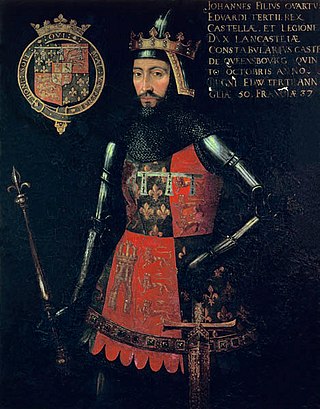
John of Gaunt, Duke of Lancaster was an English-French royal prince, military leader, and statesman. He was the fourth son of King Edward III of England, and the father of King Henry IV. Due to Gaunt's royal origin, advantageous marriages, and some generous land grants, he was one of the richest men of his era, and was an influential figure during the reigns of both his father and his nephew, Richard II. As Duke of Lancaster, he is the founder of the royal House of Lancaster, whose members would ascend the throne after his death. His birthplace, Ghent in Flanders, then known in English as Gaunt, was the origin of his name. When he became unpopular later in life, a scurrilous rumour circulated, along with lampoons, claiming that he was actually the son of a Ghent butcher. This rumour, which infuriated him, may have been inspired by the fact that Edward III had not been present at his birth.
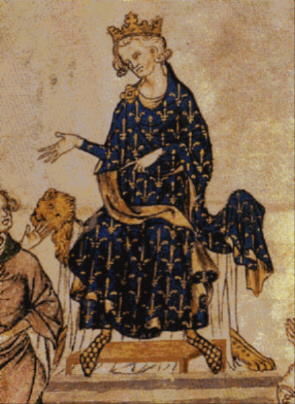
Philip VI, called the Fortunate or the Catholic and of Valois, was the first king of France from the House of Valois, reigning from 1328 until his death in 1350. Philip's reign was dominated by the consequences of a succession dispute. When King Charles IV of France died in 1328, the nearest male relative was his nephew King Edward III of England, but the French nobility preferred Charles's paternal cousin Philip.

Charles IV, called the Fair in France and the Bald in Navarre, was last king of the direct line of the House of Capet, King of France and King of Navarre from 1322 to 1328. Charles was the third son of Philip IV; like his father, he was known as "the fair" or "the handsome".

Margaret II of Avesnes was Countess of Hainaut and Countess of Holland from 1345 to 1356. She was Holy Roman Empress and Queen of Germany by marriage to Holy Roman Emperor Louis IV the Bavarian.

John IV the Conqueror KG, was Duke of Brittany and Count of Montfort from 1345 until his death and 7th Earl of Richmond from 1372 until his death.

Jacques Nompar de Caumont, 1st Duke of La Force was a Marshal of France and Peer of France. He was the son of a Huguenot, Francois de Caumont, lord of Castelnau, and Philippe de Beaupoil. He survived the St. Bartholomew's Day Massacre in 1572, but his father and older brother Armand were killed.
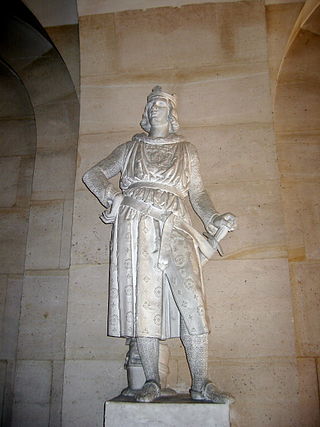
Robert III of Artois was an Artesian nobleman of the House of Artois. He was the Lord of Conches-en-Ouche, of Domfront, and of Mehun-sur-Yèvre, and in 1309 he received as appanage the county of Beaumont-le-Roger in restitution for the County of Artois, which he claimed. He was also briefly Earl of Richmond in 1341 after the death of John III, Duke of Brittany.
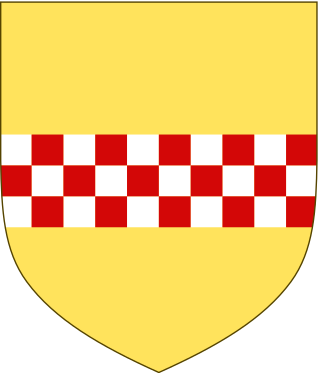
The House of La Marck was a noble family, which from about 1200 appeared as the counts of Mark.

Henri Nompar de Caumont, 3rd Duke of La Force was Duc de La Force and peer of France. He was the son of Marshal of France, Jacques-Nompar de Caumont, duc de La Force and Charlotte de Gontaut, daughter of Marshal Armand de Gontaut, baron de Biron. First marquis de Castelnau, later Duc de La Force after the death of his brother, he served King Louis XIII on many occasions in the army, under his father, as Maréchal-de-camp.

John II, lord of Chalon-Arlay was a member of the House of Chalon-Arlay. He succeeded his father Hugh I lord of Arlay to this title, and was himself succeeded by his son, Hugh II lord of Arlay.

The House of Amboise was one of the oldest families of the French nobility whose followed filiation dated back to the early twelfth century. It took its name from the town of Amboise in Touraine.
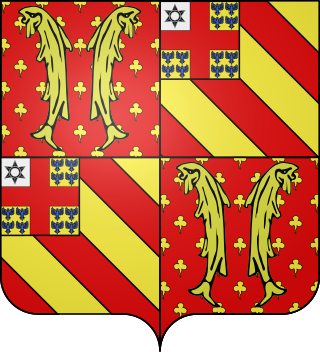
Guy I of Clermont-Nesle was a Marshal of France, Seigneur (Lord) of Offemont jure uxoris, and possibly of Ailly, Maulette and Breteuil. He might have been a Seigneur of Nesle also, or used the title "Sire of Nesle" due to his family. Difficulties about the seigneurie of Breteuil are present, and the status of Ailly and Maulette in relation to Breteuil.
Jacques Nompar de Caumont, 4th Duke of La Force was a French nobleman and peer, the son of Jacques de Caumont, Marquis de Boësse and Louise de Saint Georges. He held his late father's title from the age of two until the death of his grandfather, Henri-Nompar de Caumont, duc de La Force. Jacques-Nompar very rapidly assumed the title of duc de La Force at the closing of parliament 10 February 1678 and was acknowledged a peer, subject to conversion to Catholicism.

Archambaud de Grailly was Viscount of Castillon and Gruson from 1356 until his death, and from 1369 Count of Bénauges and Captal de Buch. He was the younger son of Peter II of Grailly and his wife, Rosamburge of Périgord and was Count of Foix by his marriage to Isabella, Countess of Foix.
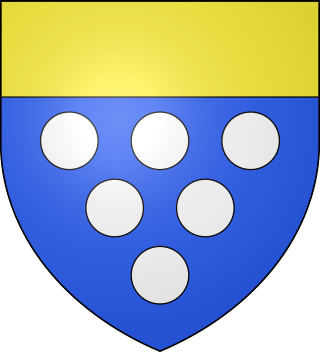
Louis I de Poitiers, Count of Valentinois, was a 14th-century French noble. Louis was killed during the Battle of Auberoche in 1345.

Renaud II, also known as Reginald de Pontibus or Renaud de Ponz, was a French nobleman and the lord of Pons in the Saintonge region of the County of Poitou from 1191 until his death. In the Anglo-French dynastic conflict, he was a strong supporter of John, King of England. He left Poitou three times to fight infidels: the Third Crusade, the Reconquista in Spain and the Seventh Crusade. He is distinguished from his uncle, Renaud de Pons, Seneschal of Gascony, in contemporary documents by the epithets senior and junior. He is possibly the same person as the troubadour Rainaut de Pons.
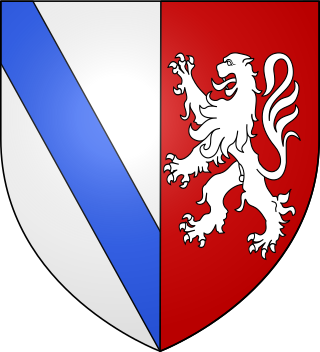
Gaillard I de Durfort, known as the Archdeacon (l'Archidiacre), was a French priest and nobleman of the Durfort family. He inherited the Lacour–Durfort lands in 1345 and abandoned his clerical career to marry Marguerite de Caumont.

Amaury IV of Craon, Lord of Craon, Chantocé, Ingrandes, Briollé, Châteauneuf-sur-Sarthe, Précigné and Sablé, Sainte-Maure, Nouâtre, Pressigny and Marcillac, Châteauneuf-sur-Charente and Jarnac, was a French noble, who was part of the Hundred Years' War.
References
- 1 2 3 Anselme (1868). Genealogical and chronological history of the Royal House of France, peers, great officers of the Crown & the House of the King: & the old barons of the Kingdom ... Firmin Didot Brothers, son and Co. p. 488.
- ↑ Sumption, Jonathan (1999). Trial by Battle. London: Faber and Faber. p. 488. ISBN 978-0-571-13896-8.